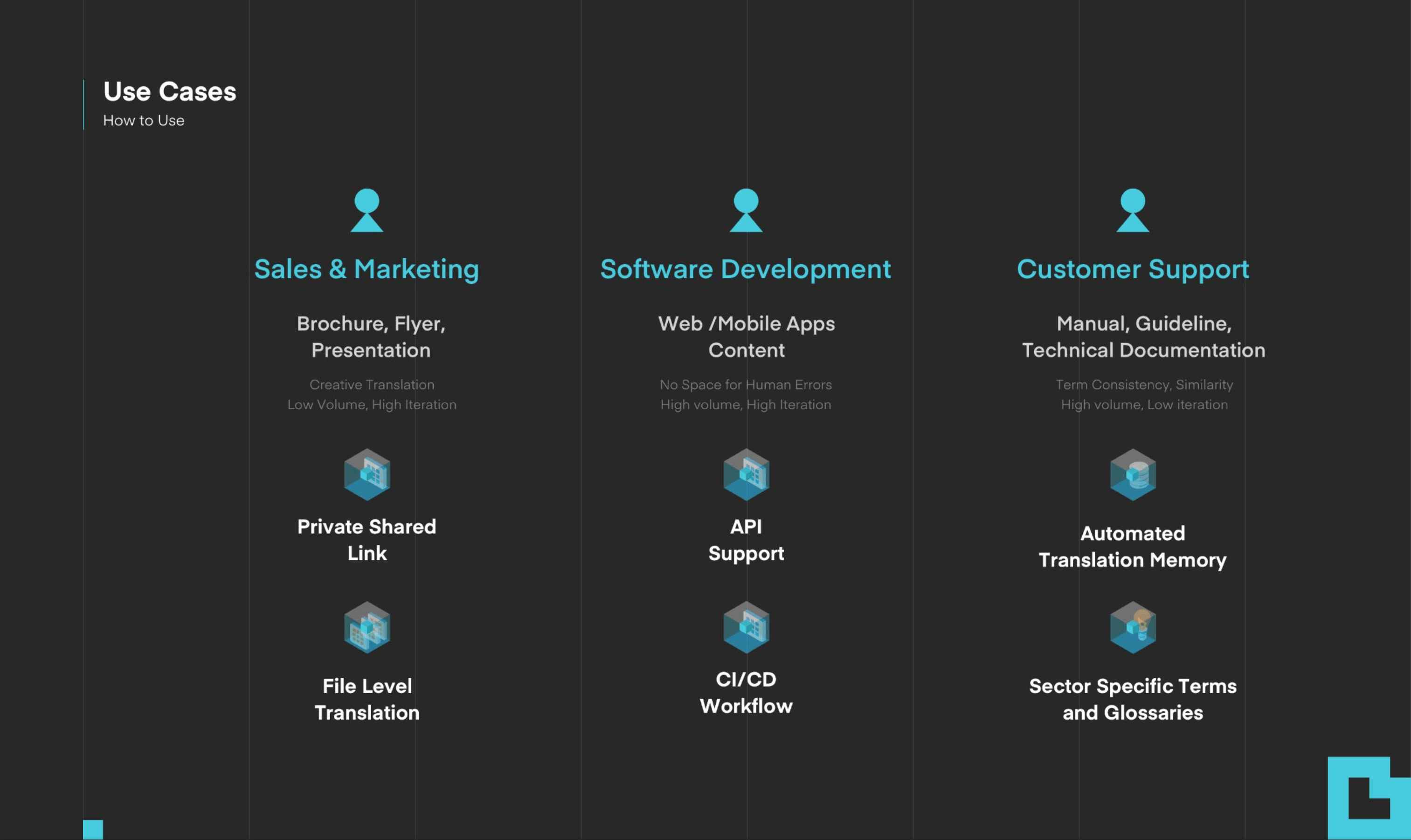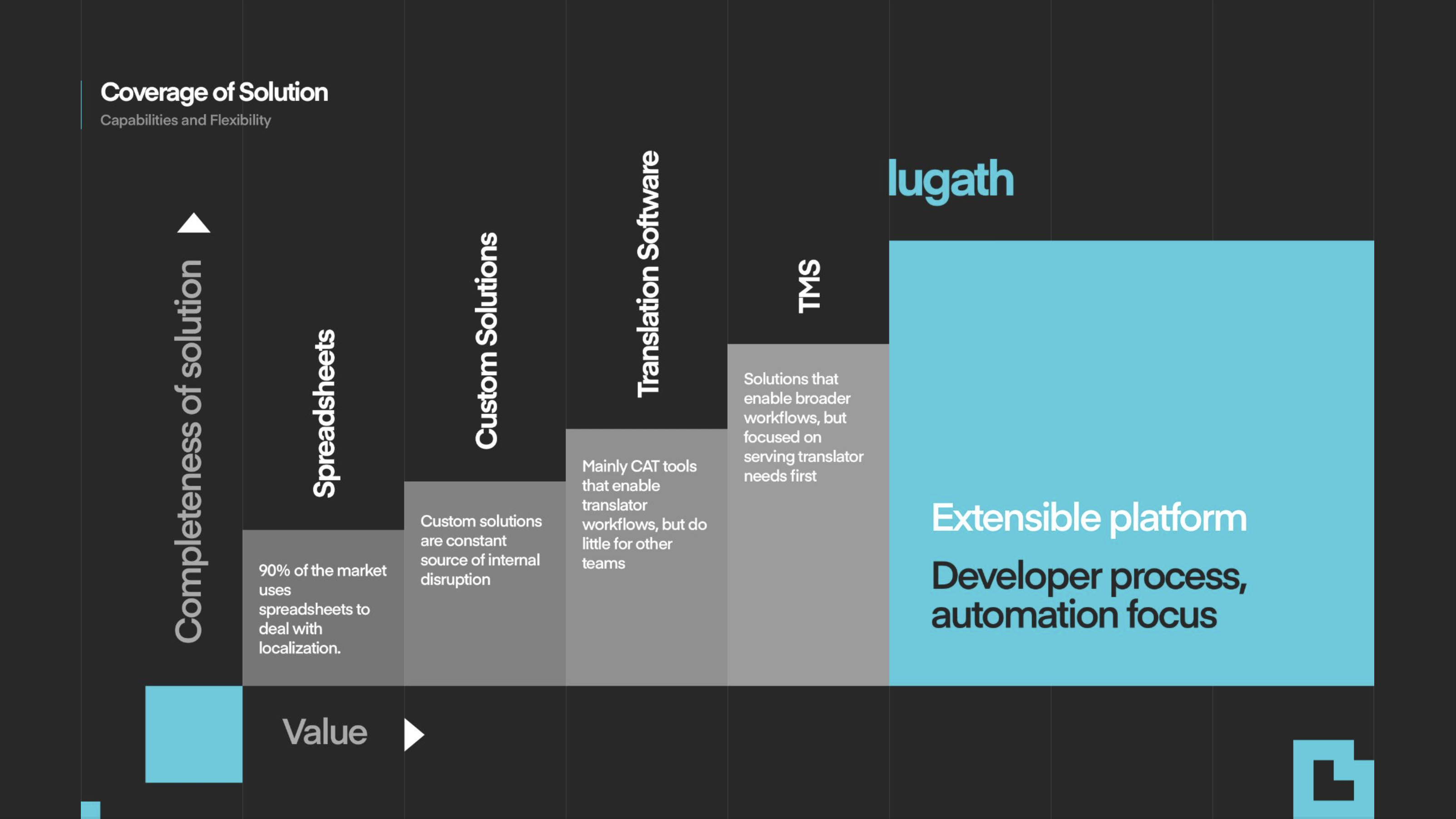Discover the ultimate localization guide for SaaS companies. Compare AI translation vs human translators and learn when to use both for maximum efficiency and quality.
Learn What Your SaaS Teams Need First
First, you need to understand the translation and localization requirements of each team. What types of content are you publishing? In which media do you plan to publish it? Is it a flyer, an email campaign, or thousands of pages of user guides? Will the content be in printed materials or on a landing page of your website? Many parameters directly affect the translation and localization of the related content. Here are some examples:

Localization for Sales and Marketing Teams
SaaS companies aim to produce more content quickly because entering a new market at the right time and growing rapidly is crucial. This is why Sales and Marketing teams generate content frequently. However, the volume of content in terms of characters or words used in translations is relatively low. The major challenge here is being creative. You need not only translation but also localization to make a significant impact. Start by selecting a tool that can translate your documents while preserving their design and file formats. Then, incorporate creative contributions into your translations from human translators or AI translation services, particularly LLMs.
Localization for Customer Support Teams
Consider the customer support teams. They provide numerous help center articles such as FAQs, manuals, and technical how-to documents, often spanning hundreds of pages. While these materials are not frequently updated, the translation volume is very high. To cut costs, you should be able to reuse previously translated sentences, which can be facilitated by a translation memory. Additionally, glossaries are essential for maintaining consistent terminology across all content. Translating everything into 50+ languages using human translators is impractical, given their pay-per-word pricing model, which averages around $0.10 per word (though this varies by language pair). This could cost you thousands of dollars. Therefore, you should opt for machine translation services that support translation memory and glossary.
To learn more, you can visit the Localization for Customer Services page.
Localization for Software Development Teams
Software development teams must manage not only the developed product but also the synchronization of the software used by other teams. The translation and localization process is also part of this automation. Consequently, they need to handle high-frequency and high-volume translations. Please remember they have a huge backlog that is waiting for prioritization. This is precisely why they prefer to integrate with developer-friendly localization services that offer API support to streamline CI/CD processes.
Visit the localization guide for SaaS company developers for more information.
Decide How to Sync Your Language Data Among Teams
Companies want to produce more content faster because going into the market at the right time and growing fast is very important. Companies with this awareness prefer to manage the process by establishing teams inside instead of outsourcing. However, there are so many differentiated products and services in the market that each team chooses to proceed with different solutions in line with their localization needs The main problem starts here. How will these teams and software synchronize for a great localization process?

Spreadsheets:
90% of the industry is stuck in solutions such as Excel and Google Sheets to transfer language data among teams. The scope of these documents for solution is very low. You can not share all the context with human translators if necessary.
Custom Solutions:
Some companies have their solutions, but these solutions are often far away from the industry standards. Generally rely on sending these spreadsheets to LSP with a semi-automated approach. Moreover, it puts an additional software development and management burden on companies to the main workflow.
Translation Software:
There are translation tools that we call CAT Tool, but since they are designed according to the translators’ workflow, they cannot produce any value for other teams.
TMSs:
The same is true for TMSs, which we call Translation Management Systems. Enable broader workflows but focused on serving translator needs first. This is mainly preferred by translation agencies.
To automate software localization workflow;
- You do not need the all features of CAT tools or TMSs. Some of the features will be fair enough to maintain, but not all.
- Do not push yourself to learn these tools because they are not designed for SaaS companies.
- Do not try to implement your custom solutions, because there are great tools with fair prices in the market. Use your resources wisely.
You need an inclusive and expandable solution developed with an automation focus to integrate the software development and localization process as a SaaS company.
To learn more, you can also visit the localization guide for SaaS company managers and the Ultimate Guide: How to Select the Best AI Translation Tool for SaaS Companies in 5 Steps? article.
Consider Hiring a Localization Team ( Optional )
Localization Maturity
It’s time to get acquainted with a concept like localization maturity. Without going into all the details, we can briefly explain as follows. Localization maturity varies according to the techniques, tools, teams, and services a company uses in its translation and localization processes. While the localization maturity level of companies that do not use any tools or techniques is low, the localization maturity level of companies that apply all best practices is high. This information is enough for now.
Translation and Localization Team
Companies with high localization maturity often have an in-house translation/localization team and a localization manager. This team generally manages the translation and localization processes of content from all teams. You can think like a translation agency that only works for you. Such a team is generally preferred by large industry companies. I mean really big, multi-national brands. However, you can make a small setup if you have enough budget.
Almost all of the team members have translation agency background and the vast majority are translators. These teams and individuals can be positioned in very different combinations, such as translators being company employees or freelancers, the localization manager being a company employee, but still working with an outsourced translation agency. A localization manager you have positioned in the company can lead you in the translation/localization industry, where you are a foreigner. However, there are some pros and cons to working with localization managers.
Pros and Cons: Hiring a Localization Manager
Working with a localization manager will provide you with crucial support in the translation industry you are away from. However, it is necessary to be cautious about when it should be hired.
If you are an early-stage SaaS company, this process is mostly followed by team members in the Product Owner or Product Manager role. If you position the tools that have a low-level learning curve, they can quickly be understood and used within the company. You can start to automate your translation and localization process much faster, moreover, with effective budget planning.
Although localization managers will support you, since they come from a translation agency background, their tendency to position the tools they use there within the SaaS company is very high and natural. However, these tools, called CAT or TMS, are mostly designed for translators and translation agencies, as we mentioned before. They are tools with dozens of extra features that a SaaS company may not need at all. They are quite expensive as they have these features. In addition, it is very difficult for sales, marketing, after-sales support, and software development teams to get used to and use such a tool.
For this reason, we recommend that you give a good evaluation of when the localization manager you want to hire should join your SaaS company to how much they can give up the habits they have had in the past. Remember that managing the translation and localization process is your top priority, whether you have a localization manager or not.
Start Now: Translation is Not a One-Time Job
This localization guide for SaaS companies has been prepared to correct misconceptions. Contrary to popular belief, the translation and localization process is not a one-time job for SaaS companies. As long as your products or services live, you have to produce, localize, and publish new content. Many jobs, such as releasing every new feature, launching new products, or releasing marketing campaigns on time, cannot be completed until the translation and localization process is complete. It is very important to approach this topic as a continuous process and to prepare accordingly.
Do not worry! Starting with a translated draft version is more advantageous than presenting nothing in a specific language. Taking the first step and selecting the most beneficial tool is crucial for realizing your objectives in new markets. Building a translation workflow that enables continuous improvements is key to success. If you implement the right workflow, you’ll continuously improve your content based on metrics like visitor numbers, engagement rates, and user feedback, enabling you to allocate resources strategically to high-performing content.
You must start automating the translation and localization workflow right now by focusing on how you can continue this cycle healthily.
Think Big, Start Small, Move Fast.



